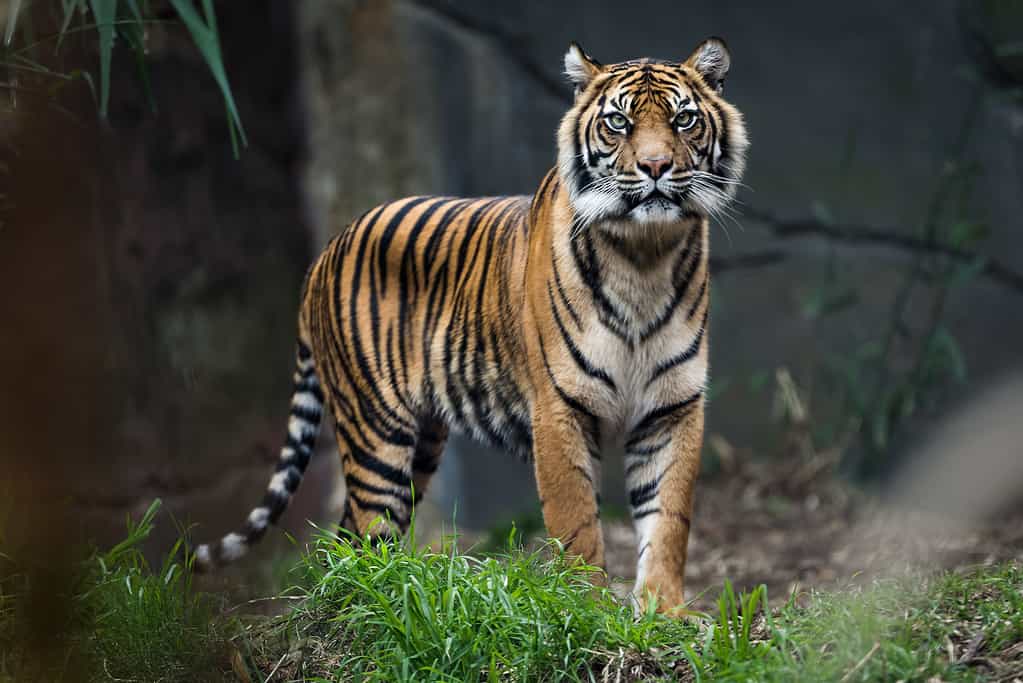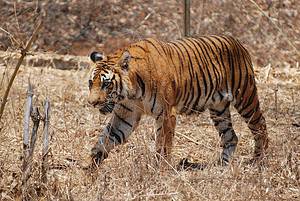Have you ever heard a tiger chuff?
Chuffing also known as prusten, is a sound tigers are famous for. This well-known vocalization is unlike any other sound these big cats make. Unlike roars, snarls, and growls, chuffing carries with it a more peaceful and reassuring message.
Follow along to discover why tigers chuff, and what other vocalizations these big cats like to make.
What Does It Mean if a Tiger Chuffs?

Tigers chuff for a number of reasons, including to reassure and guide their cubs.
©Freda Bouskoutas/iStock via Getty Images
Tigers chuff to show affection and greet one another. It’s a friendly sound that can occur between mates, or between a mother and her cubs. A chuffing tiger mother is using vocalization to soothe and calm her young. The familiar sound is both friendly and reassuring.
How does a tiger chuff? To make this purr-like sound a tiger must first close their mouth completely. Then they can quickly blow air through their nostrils. The forced air makes a sort of snorting sound, which is the chuff. It’s also common for a tiger to bob their head up and down, another display of their cheerful mood.
It turns out that although tigers are the most famous chuffers, they’re not the only ones making this noise. Chuffing is something clouded leopards, jaguars, and snow leopards do. The friendly, non-aggressive vocalization helps strengthen bonds.
Other Sounds Tigers Can Make
- Growling: Warning to other tigers, animals, or humans.
- Contact Calls: Sound to peacefully reclaim territory
- Roaring: Audible up to 2 miles away
- Mrr: Resembles a cow’s moo.
- Arf: Resembles a dog
- Click-growls or Click-roar: Shows aggression
- Snarls: Aggressive, threatening sound
- Grunting: Low, guttural sounds
- Moaning: Play a role in guiding cubs
- Gasping: Intense, breathy sounds
- Bark: Can indicate a wide range of emotions ranging from curious to annoyed
As you can see, chuffing is just one of the sounds tigers can make. These big cats are also capable of groans, growls, roars, moans, and snarls.
Snarls
Tigers snarl in response to threats, fights with other tigers, or when facing unknown enemies. The aggressive vocalization serves as both a warning and a scare tactic. It’s hands down one of the most intimidating sounds you’ll ever hear.
Click-Growl or Click-Roar
Tigers also make a click-growl, which is like a miniature version of their roar. Click-growls are made possible by forcing air over the vocal cords and through an open mouth. This is the type of vocalization a tiger might make when defending their food.
Paralyzing Roar
Finally, tigers are most famous for their powerful, and sometimes paralyzing roar. Elizabeth von Muggenthaler, a bioacoustician, presented research on tiger roars at the Acoustical Society of America meeting. The study found that tiger roars at around 18 hertz are so low and loud, they may have a paralyzing effect. It’s also possible these infrared sounds carry information for other tigers to decipher.
Can Tigers Meow?

Tigers aren’t capable of purring or meowing, but they can produce powerful roars.
©Thorsten Spoerlein/iStock via Getty Images
Tigers can chuff, roar, growl, and moan. But what about meows? As it turns out, not all cats are capable of making this famous cat sound. Snow leopards, lion cubs, cheetahs, and cougars can meow, but lovely striped tigers cannot.
Tigers can’t meow for the same reason they can’t purr; their anatomy just won’t allow it. These big cats have a long line of tough cartilage connecting to their skulls. The cartilage makes it impossible for tigers to meow or purr, while also giving them the power to produce bone-shattering roars.
The photo featured at the top of this post is © Thinker360/iStock / Getty Images Plus via Getty Images
Thank you for reading! Have some feedback for us? Contact the AZ Animals editorial team.







